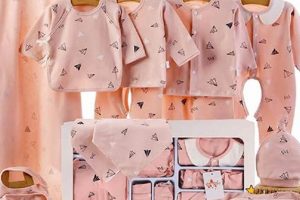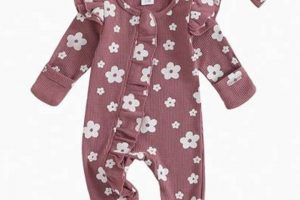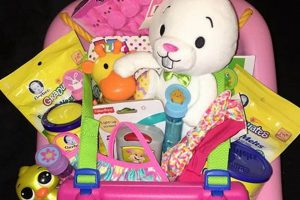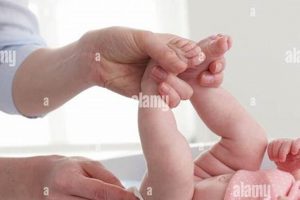Textiles specifically designed for a baby girl’s sleeping environment typically include a fitted sheet, a quilt or comforter, a dust ruffle (skirt), and sometimes a bumper pad (though these are increasingly discouraged for safety reasons). These items are chosen to create a visually appealing and comfortable space for the infant. For example, a set might feature a pink floral pattern with a soft cotton fabric for the sheet.
The selection of appropriate items is crucial for establishing a safe and nurturing atmosphere for the child. Considerations include the breathability of the materials used, their hypoallergenic properties, and the absence of small parts that could pose a choking hazard. Historically, these items were often hand-sewn and represented a significant investment of time and care; today, a wide range of commercially produced options are available, offering diverse styles and price points while aiming to provide comfort and safety for the infant.
The following discussion will delve into the different types of materials commonly used, the safety standards that apply to these products, and design considerations that contribute to a stimulating yet calming environment. Furthermore, it will explore the practical aspects of care and maintenance for these essential nursery elements.
Essential Considerations for Furnishing an Infant’s Sleeping Quarters
Selecting appropriate textiles for an infant’s sleeping environment requires careful consideration of safety, comfort, and aesthetic appeal. Prioritizing these aspects contributes to a secure and nurturing space for the child.
Tip 1: Prioritize Breathable Fabrics: Opt for natural materials such as cotton, muslin, or bamboo. These fabrics promote airflow, reducing the risk of overheating and creating a more comfortable sleep environment. Synthetic materials may restrict airflow and are generally less desirable.
Tip 2: Ensure a Snug Fitted Sheet: The fitted sheet should fit the mattress snugly with no looseness. A loose sheet can pose a suffocation hazard. Check the dimensions of the mattress and select a sheet specifically designed for that size.
Tip 3: Avoid Loose Bedding in the Crib: Refrain from using loose blankets, pillows, and bumper pads. These items increase the risk of sudden infant death syndrome (SIDS). A sleep sack or wearable blanket is a safer alternative for keeping the infant warm.
Tip 4: Choose Flame-Retardant-Free Options: While flame retardants are designed to prevent fires, some chemicals used can be harmful. Seek out products that are explicitly labeled as flame-retardant-free.
Tip 5: Consider Hypoallergenic Materials: Infants can have sensitive skin. Hypoallergenic materials help minimize the risk of allergic reactions and skin irritation. Look for certifications such as Oeko-Tex, which indicates that the product has been tested for harmful substances.
Tip 6: Establish a Coordinated Color Palette: Maintain a consistent color scheme throughout the sleeping quarters. Soft, pastel shades are often chosen for their calming effect, but any color palette can be effective with careful planning. Consistency enhances the visual appeal and promotes a tranquil atmosphere.
Tip 7: Regularly Wash and Sanitize: Proper hygiene is paramount. Wash all items regularly in hot water with a gentle, fragrance-free detergent. This helps to eliminate allergens and bacteria, ensuring a clean and healthy sleep environment.
Selecting the appropriate fabrics involves balancing aesthetic preferences with the critical need to protect the infant. Prioritizing breathable, safe materials and adhering to safety guidelines minimizes risks and supports optimal comfort.
The subsequent sections will address specific design trends and innovative products in this product sector, highlighting options that combine safety, style, and functionality.
1. Fabric Breathability
Fabric breathability is a critical characteristic of textiles used in infant sleeping quarters, directly impacting the child’s comfort and safety. The term refers to the ability of a material to allow air and moisture to pass through its fibers, thus facilitating temperature regulation. Non-breathable fabrics can trap heat and moisture, leading to overheating, discomfort, and potentially increasing the risk of skin irritation or, in extreme cases, contributing to sudden infant death syndrome (SIDS) risk factors. For example, a fitted sheet made of tightly woven polyester, compared to one made of open-weave cotton muslin, exhibits significantly lower breathability.
In the context of outfitting a sleeping space specifically for a baby girl, the selection of breathable materials becomes paramount. Cotton, linen, bamboo, and muslin are frequently chosen for their inherent breathability and soft texture, reducing the likelihood of overheating and promoting a more comfortable sleep environment. The practical significance of this is evident in warmer climates, where breathable bedding can significantly reduce the risk of heat-related discomfort. Furthermore, the use of breathable fabrics extends beyond sheets to include blankets and wearable blankets, all contributing to the overall thermal regulation of the infant’s microclimate within the crib.
The emphasis on fabric breathability represents a critical element of responsible textile selection. Prioritizing breathable fabrics when acquiring these textiles for a baby girl’s room requires attentiveness to material composition and weave. Overlooking breathability introduces preventable risks. Therefore, healthcare providers and caregivers stress the importance of choosing textiles that facilitate airflow and moisture evaporation, underscoring the direct connection between fabric breathability and infant well-being within sleeping quarters.
2. Snug Fitted Sheet
The “Snug Fitted Sheet” is a foundational element of safe and appropriate “baby girl nursery bedding.” It serves as the primary interface between the infant and the mattress, and its secure fit is crucial for minimizing hazards within the crib environment.
- Prevention of Suffocation Risks
A properly fitted sheet minimizes the risk of loose fabric that could potentially cover the infant’s face and obstruct breathing. The elastic edges should grip the mattress firmly, preventing the sheet from becoming dislodged during sleep. In contrast, an ill-fitting sheet could bunch up or detach, creating a dangerous sleeping environment.
- Maintenance of a Clean Sleep Surface
The fitted sheet provides a barrier against spills, spit-up, and other messes, protecting the mattress from contamination. Regular washing of the fitted sheet is essential for maintaining hygiene and preventing the growth of bacteria or mold. A clean sleep surface contributes to the overall health and well-being of the infant.
- Ensuring Correct Size and Fit
Selecting the correct size fitted sheet is paramount. Crib mattresses adhere to standardized dimensions; therefore, caregivers must ensure the sheet matches these specifications. A sheet that is too large will not fit snugly, while one that is too small may tear or become dislodged. Proper size verification is a fundamental safety precaution.
- Material Composition and Safety Standards
The composition of the fitted sheet material impacts both safety and comfort. Breathable, natural fibers such as cotton are preferred to synthetic materials that may restrict airflow. Additionally, fitted sheets should adhere to relevant safety standards regarding flame retardancy and the absence of harmful chemicals. Choosing certified safe materials is a crucial consideration.
The importance of a “Snug Fitted Sheet” within “baby girl nursery bedding” transcends mere aesthetics. It is a critical safety component that directly influences the well-being of the infant. Proper selection and maintenance of the fitted sheet are essential responsibilities of caregivers seeking to establish a secure and healthy sleeping environment.
3. Safe Sleep Practices
Adherence to established safe sleep practices is paramount when selecting and utilizing items for a baby girl’s sleeping environment. The composition and arrangement of textiles within the sleeping space significantly impact the infant’s safety and well-being. Neglecting these guidelines elevates the risk of preventable adverse events.
- Firm Sleep Surface
The mattress must be firm and flat, devoid of soft spots or indentations. Soft surfaces increase the risk of suffocation. The chosen bedding should not compromise the firmness of the mattress. For example, avoid placing padding or cushioning beneath the fitted sheet, as this negates the safety benefits of a firm surface.
- Bare Crib Environment
The crib should contain only the fitted sheet and the infant. The presence of loose blankets, pillows, bumper pads, and toys elevates the risk of suffocation, entrapment, and strangulation. These items offer no safety benefits and are actively discouraged by pediatric experts. The aesthetic appeal of a fully decorated crib must be secondary to the infant’s safety.
- Back Sleeping Position
Infants should be placed on their backs for sleep, every time. This position significantly reduces the risk of Sudden Infant Death Syndrome (SIDS). The type of textiles used does not alter the importance of this practice; however, caregivers must ensure that textiles do not inadvertently encourage the infant to roll onto their stomach. For instance, avoid using wedges or positioning devices.
- Appropriate Swaddling (If Used)
If swaddling is employed, it must be done correctly to prevent hip dysplasia. The swaddle should be snug around the torso but allow freedom of movement at the hips and knees. Discontinue swaddling when the infant shows signs of attempting to roll over. The choice of swaddling material should prioritize breathability to prevent overheating. For instance, lightweight muslin is a preferable option to heavier, less breathable fabrics.
In summary, while aesthetically pleasing textiles may be desirable, adherence to safe sleep practices is non-negotiable. The arrangement and composition of the items in the nursery must prioritize the infant’s safety above all else. Caregivers should consult pediatric guidelines and exercise diligence in maintaining a safe sleep environment.
4. Hypoallergenic Material
The selection of hypoallergenic materials for infant bedding is a critical consideration due to the heightened sensitivity of newborns. Infant skin is thinner and more permeable than adult skin, rendering it more susceptible to irritants and allergens. Exposure to allergenic substances can trigger reactions ranging from mild skin rashes and eczema to respiratory issues, disrupting sleep and overall well-being. The connection between “hypoallergenic material” and “baby girl nursery bedding” is therefore one of direct cause and effect: the use of allergenic materials increases the likelihood of adverse reactions, while the use of hypoallergenic options minimizes that risk. The importance of this choice lies in creating a safe and comfortable sleep environment, free from unnecessary irritants.
Examples of hypoallergenic materials commonly used in infant bedding include organic cotton, bamboo, and certain types of microfiber. Organic cotton is grown without pesticides or synthetic fertilizers, reducing the potential for chemical residues that could irritate sensitive skin. Bamboo fibers possess natural antimicrobial properties and are known for their softness and breathability. Microfiber, when tightly woven and produced without harmful dyes or finishes, can also provide a hypoallergenic alternative. In contrast, conventionally produced cotton, synthetic fabrics treated with harsh chemicals, or bedding containing down feathers are more likely to trigger allergic reactions in susceptible infants. Real-life examples include nurseries where infants experienced relief from eczema symptoms after switching from conventional cotton sheets to organic cotton sheets, or cases where respiratory distress lessened after removing feather-filled pillows from the crib. The practical significance is clear: informed material choices can directly improve an infant’s comfort and health.
The use of hypoallergenic materials in baby girl nursery bedding is not merely a marketing trend, but a practical necessity for safeguarding infant health. While selecting such materials is a positive step, challenges remain in ensuring the purity and safety of these products. Mislabeling or the presence of hidden allergens can undermine the benefits. Caregivers must scrutinize product labels, seek certifications from reputable organizations (such as Oeko-Tex), and wash all new bedding thoroughly before use. By prioritizing hypoallergenic materials and remaining vigilant about product quality, caregivers can create a sleeping environment that promotes the well-being of the infant, thereby supporting healthy development and reducing the risk of allergic reactions.
5. Color Palette Harmony
Color palette harmony, within the context of “baby girl nursery bedding,” denotes the cohesive and balanced arrangement of colors used in the textiles and decorative elements of the infant’s sleep environment. This harmony is not merely an aesthetic consideration; it directly impacts the infant’s visual stimulation and potentially their developing emotional state. A disjointed or overly stimulating color scheme may lead to overstimulation, while a carefully curated palette can promote a sense of calm and security. Cause and effect are evident: discordant colors can contribute to restlessness, while harmonious hues can facilitate relaxation. Therefore, the importance of “Color Palette Harmony” as a component of “baby girl nursery bedding” extends beyond visual appeal to encompass the infant’s overall well-being. Consider, for example, a nursery utilizing a palette of soft pinks, creams, and light greens; this combination often evokes a sense of tranquility, whereas a room decorated with clashing primary colors might be overly stimulating for a newborn.
The practical application of color palette harmony involves careful selection of bedding materials, wall colors, and accent pieces. While traditional “baby girl nursery bedding” often emphasizes pink hues, modern approaches embrace a broader spectrum of colors and patterns. Neutral palettes, such as grays, whites, and beiges, offer versatility and can be paired with subtle pops of color through accent pillows or artwork. Monochromatic schemes, using varying shades of a single color, create a sense of depth and sophistication. Real-world examples include nurseries designed using a “nature-inspired” palette of greens, browns, and blues to create a calming outdoor atmosphere, or rooms utilizing a “vintage” palette of muted pastels to evoke a sense of nostalgia and comfort. These choices reflect a growing understanding of the psychological impact of color on infants and a shift towards creating environments that are both visually appealing and developmentally appropriate.
In conclusion, achieving color palette harmony in “baby girl nursery bedding” is a deliberate process requiring thoughtful consideration of the infant’s developmental needs. While aesthetic preferences play a role, the primary goal is to create a soothing and visually balanced environment. Challenges may arise in balancing personal style with evidence-based design principles. The ultimate aim is to establish a nursery that not only pleases the eye but also contributes to the infant’s sense of security and well-being, thereby aligning with the broader theme of nurturing infant development through thoughtful environmental design.
Frequently Asked Questions
This section addresses common inquiries and clarifies prevalent misconceptions regarding the selection and use of textiles for an infant girl’s sleeping environment. The information provided is intended to promote informed decision-making and support safe sleep practices.
Question 1: Are bumper pads necessary for crib safety?
Current pediatric recommendations advise against the use of bumper pads in cribs. While historically intended to prevent injury, they pose a suffocation and entrapment risk. Their presence offers no demonstrable safety benefit and may impede airflow.
Question 2: What is the appropriate TOG rating for a baby sleep sack?
The Thermal Overall Grade (TOG) rating indicates the warmth of a sleep sack or wearable blanket. Selection of an appropriate TOG rating depends on the ambient temperature of the room. Higher TOG ratings are suitable for colder environments, while lower ratings are appropriate for warmer climates. Overheating should be avoided.
Question 3: How frequently should baby bedding be washed?
Bedding should be washed prior to initial use and regularly thereafter. Fitted sheets require more frequent washing due to direct contact with the infant. Spills, spit-up, or other soiling necessitate immediate laundering. A general guideline suggests washing bedding at least once per week.
Question 4: What are the risks associated with flame retardants in bedding?
Certain flame retardant chemicals, previously used in bedding, have been linked to adverse health effects. Opting for products explicitly labeled as flame-retardant-free mitigates this risk. Research material composition and certifications carefully.
Question 5: Is it safe to use hand-me-down bedding?
Used bedding may be suitable provided it is in good condition and meets current safety standards. Thoroughly inspect the items for wear and tear, including loose threads or compromised elastic. Launder the items prior to use. If the origin or composition of the bedding is unknown, exercising caution is advisable.
Question 6: What certifications should I look for when purchasing bedding?
Certifications such as Oeko-Tex Standard 100 indicate that the product has been tested for harmful substances. The Global Organic Textile Standard (GOTS) ensures that the product is made from organic materials and adheres to environmentally and socially responsible production practices. These certifications offer assurance of product safety and quality.
Safe sleep practices and informed material selection are paramount in creating a secure and nurturing sleeping environment. Prioritizing evidence-based recommendations and verifying product certifications contribute to the well-being of the infant.
The subsequent section will explore emerging trends and innovative products in the baby girl nursery bedding market, emphasizing options that prioritize safety and developmental appropriateness.
Concluding Remarks on Baby Girl Nursery Bedding
The preceding discussion has underscored the multifaceted nature of selecting textiles for an infant girl’s sleeping environment. Key considerations extend beyond aesthetics to encompass safety, material composition, and adherence to established safe sleep guidelines. Prioritizing breathable fabrics, ensuring a snug fitted sheet, and avoiding loose bedding are fundamental principles. Furthermore, the selection of hypoallergenic materials and a harmonious color palette contributes to a nurturing and developmentally appropriate space.
The creation of a secure and comfortable sleep environment is a critical responsibility. Continued vigilance regarding product safety standards and a commitment to evidence-based practices are essential. Caregivers are encouraged to remain informed about evolving recommendations and prioritize the well-being of the infant in all decisions related to “baby girl nursery bedding.” The informed selection and utilization of these textiles directly impact the infant’s health and development, underscoring the significance of this aspect of infant care.







